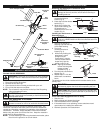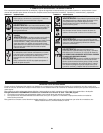
RULES FOR SAFE OPERATION
• CORD SETS: Make sure your cord set is in good condition. When
using a cord set, be sure to use a cord that is heavy enough to
carry the current that your unit will draw. An undersized cord set
will cause a drop in line voltage resulting in loss of power and
overheating. See the operator’s manual for the unit that will power
this attachment for the recommended cord size.
• Inspect all extension cords and the unit power connection
periodically. Look closely for deterioration, cuts or cracks in the
insulation. Also inspect the connections for damage. Replace the
cords if any defects or damage appear.
• Prevent disconnection of the electric powerhead from extension
cord during operation by using a plug-receptacle retaining strap,
connector, or by making a knot as shown below:
• Avoid dangerous environments. Never operate your unit in damp
or wet conditions. Moisture is a shock hazard.
• Do not use the unit in the rain. Do not use in or around water. Do
not use on wet hedges or shrubbery.
• Do not handle the plug or unit with wet hands or standing on any
wet surfaces.
• Do not leave the unit plugged in when not in use, changing
attachments or add-ons, or while being serviced.
OTHER SAFETY PRECAUTIONS
• DO NOT operate a pole saw with one hand! Serious injury to the
operator, helpers, or bystanders may result from one-handed
operation. A pole saw is intended for two-handed use.
• Do not operate a pole saw if you are fatigued.
• Do not wear loose clothing or jewelry, as they can get caught in
moving parts. Non-skid footwear is recommended when working
outdoors. Wear protective hair covering to contain long hair.
• Use safety glasses, safety footwear, snug fitting clothing,
protective gloves, and protective hearing and head gear.
• Keep the work area clean. Cluttered areas invite injuries. Do not
start cutting until you have a clear work area, secure footing, and
a planned retreat path from the falling branches.
• Stay Alert. Watch what you are doing. Use common sense. Do not
operate the pole saw when you are tired. Keep all parts of your body
away from the saw chain when the motor is operating. Before you
start the saw, make sure the saw chain is not contacting anything.
• Disconnect the pole saw when not in use, before servicing, and when
changing accessories and attachments such as saw chain and guard.
• Check damaged parts. Before further use of the pole saw, a guard or
other part that is damaged should be carefully checked to determine
that it will operate properly and perform its intended function. Check
for alignment of moving parts, binding of moving parts, breakage of
parts, mounting, and any other conditions that may affect its
operation. A guard or other part that is damaged should be properly
repaired or replaced by an authorized service center, unless otherwise
indicated in this instruction manual.
• Use extreme caution when cutting small sized brush and sapling,
as slender material may catch the saw chain and be whipped
toward you or pull you off balance.
• Do not operate a pole saw in a tree unless you are specifically
trained to do so. When cutting a limb that is under tension, be
alert for spring back so that you will not be struck when the
tension in the wood fibers is released.
• Do not expose the pole saw to rain. Do not use the pole saw in
damp or wet locations.
•
Do not use the pole saw in the presence of flammable liquids or gases.
• All pole saw service, other than the items listed in the operator’s
manual safety and maintenance instructions, should be
performed by competent pole saw personnel. Do not attempt to
repair it yourself; there are no user serviceable parts inside.
• The pole saw will do a better and safer job when used at the rate
for which it was intended.
• Use the right tool. Cut wood only. Do not use the pole saw for
purposes for which it was not intended. For example, do not use the
pole saw for cutting plastic, masonry, or non-building materials.
•
Use devices, such as low-kickback chain, guide bar nose guards, chain
brakes and special guide bars, which reduce the risks associated with
kickback.
• There are no other replacement components for achieving
kickback protection in accordance with CSA Z62.3.
• Do not operate a pole saw that is damaged, improperly adjusted,
or not completely and securely assembled. Be sure that the saw
chain stops moving when the trigger is released.
• Do not attempt operations beyond your capacity or experience.
• Never remove, modify or make inoperative any safety device
furnished with your unit.
• This saw is intended for infrequent use by homeowner’s, cottagers
and campers, and for such general applications such as clearing and
pruning. It is not intended for prolonged use. If the intended use
involves prolonged periods of operation, this may cause circulatory
problems in the user’s hands due to vibration. It may be appropriate
to use a saw having an anti-vibration feature.
•
Safety clothing required by your safety organizations, government
regulations, or your employer should be used; otherwise, snug fitting
clothing, safety footwear, and hand and ear protection should be worn.
• Low-kickback saw chain is chain that has met the kickback
performance requirements of ANSI B175.1-1991 and is in
accordance with CSA Z62.3. Do not use other replacement chain
unless it has met these requirements for your specific model.
• Do not use any other cutting attachment or accessories. Use only
original equipment manufacturer replacement parts and accessories,
which are designed specifically to enhance the performance and
maximize the safe operation of our products. Failure to do so may
cause poor performance and possible injury. Use only the chain and
bar supplied with this product. Do not use any other cutting
attachment. Use of such attachments will void your factory warranty
and could result in serious bodily injury.
• Never touch the chain or attempt to service the saw while the
engine is running. Make sure all moving parts have stopped.
Allow the chain to cool, as the chain can be hot.
• Check the bar and chain at frequent intervals for proper
adjustment. Make sure the bar and chain are properly tightened
and sharpened. Visually inspect for damage. Repair any damage
before restarting or operating the pole saw.
• Do not cut near electrical cables or power lines.
• Do not use the pole saw to fell a tree. Use a standard chain saw
for this application.
MAINTENANCE AND STORAGE
• Allow the unit to cool before storing or transporting. Be sure to
secure the unit while transporting.
• Always use the transport guard on the bar and chain during
transportation and storage.
• Store the unit in a locked up and dry or high and dry place to
prevent unauthorized use or damage, out of the reach of children.
• Never douse or squirt the unit with water or any other liquid. Keep
handles dry, clean and free from debris. Clean after each use.
• Keep these instructions. Refer to them often and use them to
instruct other users. If you loan someone this unit, also loan them
these instructions.
• Only qualified personnel should perform any repairs or
maintenance procedures that are not described in this manual.
SAVE THESE INSTRUCTIONS
3
DANGER:
RISK OF CUT OR SHOCK — Keep hands
away from blades. Keep one hand on assist handle on the
powerhead and on the loop handle of attachment when
power is on. Do not attempt to remove cut material or hold
material to be cut when blades are moving. Make sure the
switch on the power unit is off when clearing jammed
material from blades. Do not grasp the exposed cutting
blades or cutting edges of the pole saw. Wear gloves when
handling the blade. Do not operate unit with one hand.
Extension
Cord
Powerhead
Cord
Powerhead
Cord
Extension
Cord


















